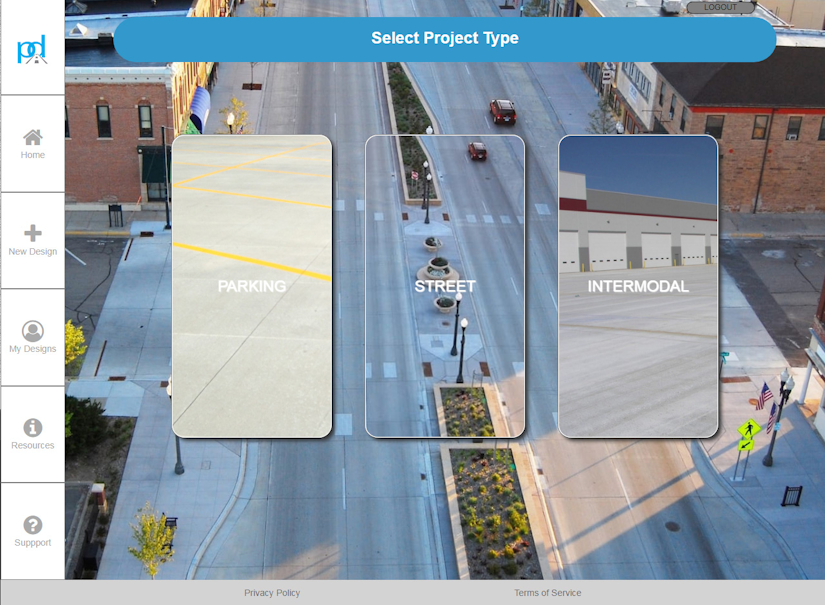Concrete and cement Industry groups introduce free web-based pavement design platform | Aggregate, Excavation, Dump Truck Company

A free, new online concrete pavement design tool now offers features and benefits never before available to the cement and concrete industry – and engineers are snapping it up for use in the few weeks since its launch.
Industry groups worked together on the two-year effort to launch the highly interactive tool PavementDesigner.org for city, county, and consultant engineers, academia, or anyone involved in design of roadway, industrial, and parking area pavements.
“I’m please to tell you that we are just over two weeks into the public launch of PavementDesigner.org,” Gerald Voigt, president and CEO of American Concrete Pavement Association, recently announced to editors at the World of Concrete trade show in Las Vegas.
Since the January 8 launch, he says, the website had logged hundreds of designs made by engineers throughout the world, which signals much promise for its use in the future.
“We’re very excited about the future of this PavementDesigner.org software,” Voigt says.
“Not only has it brought the industry’s design programs into one place, but we feel fortunate to be introducing it at a time in which we anticipate an improvement in the funding on transportation infrastructure.”
Voigt said the new software, a result of the biggest collaborative effort ever by ACPA and industry partners, represents a “paradigm shift” in the process used to educate, train and foster concrete pavement designs.

Gerald “Jerry” Voigt
“We previously developed our design methods and our programs independently and offered them to the engineering community independently. We came together to provide one platform,” he says, as a way to offer one source to represent the industry’s recommendations on proper pavement design for all markets and types.
This includes designs for roadways, streets, industrial facilities, parking lots and other commercial projects. It encompasses different methods: bonded and unbonded, standard jointed pavement design, continuously reinforced pavement design and roller compacted concrete pavement design.
The new platform is offered to anyone to use online, which is yet another paradigm shift, according to Voigt. “There’s no more limitations on use,” and it’s available to anyone, anywhere, 24-7.
“PavementDesigner guides professional designers but allows for fully customizable design inputs,” he says.
What it offers
PavementDesigner improves upon traditional pavement design software programs with these features:
- No cost, no burden – The platform and is offered completely free of charge, eliminating the expense and burden of ordering software and updates, licenses, etc.
- Immediate access – The platform brings the industry’s best pavement design programs together into a single website that allows professionals to design pavements immediately.
- Cloud storage/retrieval – Users have the option of creating a user ID and password to save their design work, as well as to retrieve projects using any digital device.
- Automatic updates and improvements – The online system is automatically updated when new content or details are warranted. Users will not have to download updated software or “patches.”
Working with the ACPA in the initiative are the Ready Mixed Concrete (RMC) Research & Education Foundation and the Portland Cement Association (PCA). Additional funding and support came from the Roller Compacted Concrete (RCC) Pavement Council.
“ACPA was excited to serve as the project leader for PavementDesigner, working closely with our industry partners and our software designer,” says Eric Ferrebee, EIT, director of technical services for ACPA, the national trade association for the concrete pavement industry.
The platform puts, all in one place, the industry’s best design solutions for concrete and cement-based pavement design, Ferrebee says.
“PavementDesigner.org represents a dramatic shift in solutions availability to designers of streets, roads, parking lots, and industrial facilities. By bringing multiple programs together in one package and eliminating the cost and time to download software, updates, and patches, we have removed barriers and enabled designers to select the best option for pavement designs.”
Wayne Adaska, Portland Cement Association’s director of pavements, says the comprehensive but easy-to-use pavement design tool not only covers full-depth concrete, but also provides design solutions for concrete overlays and composite pavements.
“Further, the tool includes other cement-based materials like roller-compacted concrete, cement-treated base and full-depth reclamation with cement,” Adaska adds.
How to use PavementDesigner.org
PavementDesigner guides the user through three basic stages of pavement design.

The user first selects the project type, whether it’s for parking, street, or an intermodal facility. The system then guides the user through the project level details and the design of the pavement structure. Each module has help screens and conversions built in to assist the user in entering pavement structure details.
After pavement structure information is entered and calculated, the user moves to a summary screen where the pavement design may be reviewed, analyzed, printed, and/or saved, ACPA says.
“PavementDesigner presents a unique experience to the user which logically steps the designer through the pavement design process,” explains Brian Killingsworth, the National Ready Mixed Concrete Association’s executive vice president of local paving.
“The user experience and functionality of the website were foremost in our minds throughout the development. Couple that with state-of-the-art technical methods and reporting, and the user will find the design process to be exceptional.”
Help is readily available
Designers can access design support by using contact information found on the website to reach a network of pavement design experts.
The portal includes helpful resources that are available from the sidebar. Users can view a PavementDesigner introductory video; view the platform’s map and methodology visual to see solutions and a process flow; and watch another video that shows how to use the portal to design jointed plain concrete pavement.
The resource section also includes details from drawings of various concrete pavement structures, as well as image and descriptions. There are web links to other resources and tools designed to assist pavement designers and others gain more insights about specific types and applications for concrete pavements.
Additional training and support materials will be added as feedback is received, the groups say.
